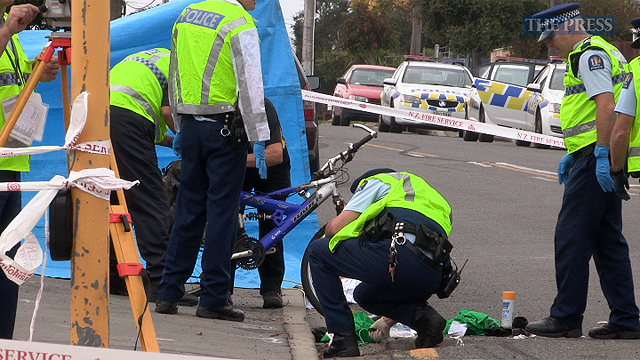With all the growth in cycleways and cycling in Chch and New Zealand at the moment, it is pertinent to recall that a lot of the recent investment in cycling is due to the tragic events of nearly 10 years ago now. That sudden “blip” of cycling deaths really was the catalyst that saw national agencies question the real safety of cycling in NZ and what to do about it. From that came the record investments in cycle networks that we see today. This post, originally from May 2013, chronicles the period of time when a coronial inquest was being held around cycle safety.
Although the memories of two recent cycling deaths in Christchurch are still fresh, some of you might recall that in late 2010, there was a spate of incidents where five people cycling died in New Zealand in less than a week, as well as a couple of other serious cycling injuries. In the wake of the ensuing media storm, the Chief Coroner announced a special inquest into cycling safety, where eight fatalities would be examined collectively and general patterns and issues identified. Anyone could seek to make a representation to the inquest hearings to present evidence that they thought relevant to cycling safety in New Zealand.
Coroner Gordon Matenga from Hamilton was appointed to oversee the hearings, which initially were based in Auckland, Hamilton, Palmerston North and Wellington, where the eight fatalities had occurred. An approach was made to the Coroner’s office pointing out that there was no easy opportunity for people in the South Island to present evidence at the hearings, and it was “good luck rather than good management” that none of the fatalities being investigated had occurred down south (in fact, eight cycling fatalities occurred in the South Island in 2009-10, including six around Christchurch). The Coroner agreed and a hearing in Christchurch was subsequently added to examine a further four cases from the South Island.

Despite all the public pressure about cycling safety, the hearings were somewhat slow to get underway; the first one in Palmerston North wasn’t until July 2011. The subsequent focus on major fatal events like the Canterbury earthquakes and the Pike River Mine explosion also slowed things as coronial efforts went into investigating these. Slowly the Coroner has heard evidence in Hamilton (August 2011), Wellington (June 2012) and Auckland (July 2012). Now, more than 2½ years since the initial fatalities, Christchurch will get its hearing next month on Tue 11th June in the Christchurch Courthouse. Due to health issues, Coroner Matenga has been replaced by Coroner Chris Davenport for this hearing.
Some of the issues raised in the hearings have generated quite a bit of media coverage. Right from the start, Coroner Matenga seemed particularly focused on the idea of making hi-vis clothing mandatory for people cycling, despite all the major problems with this idea. This particular malaise seems to have infected his fellow Coroners, as more recently there have been similar suggestions made about cases in Dunedin and Wellington, despite the victims in each case already wearing hi-vis. The idea of mandatory use of cycle lanes by cyclists was also resurrected, despite this problematic rule being removed from our regulations about a decade ago. Meanwhile there seems to have been relatively little about the “elephants in the room”, like more cycling facilities, lower speed limits, better cyclist and driver training…
Although ostensibly about cycling safety in general, the Christchurch hearing will look at evidence related to four South Island fatalities (the time to process cases means that none of the more recent fatalities can be included):
- Brennan Sharp (Port Hills, Chch, Feb 2011)
- John Mayers (Grovetown, Marlborough, May 2011)
- Graham Townley (Leeston, Canterbury, Jan 2011)
- Josephine Holmes (Westmorland, Chch, Nov 2010)
In many ways these four fatalities are somewhat atypical of the main issues facing people cycling; two of them didn’t involve a motor vehicle and in another, the cyclist was actually already lying on the road when they were hit. If they’d wanted some relevant cases they may have been better to look at Jack Fergusson (Belfast, Chch, May 2011) or Melvin Longworth (Mairehau, Chch, Oct 2011).
I will be going along to present evidence to the Coroner. After hearing about the national inquest, I was somewhat sceptical of what general pearls of wisdom could be gleaned from just eight cases. So I started looking back at all cycling fatalities since 2006, and have continued to monitor these ever since (the day job allows me to be able to access crash data). To date I have gathered about 90 on-road fatalities (including ~20 that didn’t involve a motor vehicle) and I have identified some interesting trends about these cases. They highlight things like poor motorist and cyclist behaviour, lack of infrastructure, the danger from trucks, and too high speeds. They also highlight the interesting fact that hi-vis made no difference to your chances of not being seen…
(If you would like to present evidence at the Chch hearing, you will need to act quickly to submit your material in advance. You can contact Jennifer Chalklen of the Coronial Services Unit – Jennifer.Chalklen[at]justice.govt.nz)
What do YOU think could be done to reduce cycling fatalities in New Zealand?
